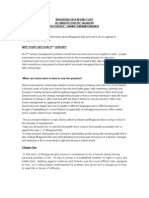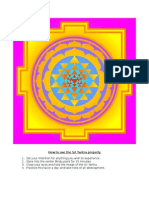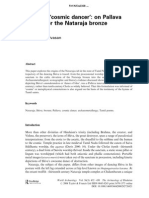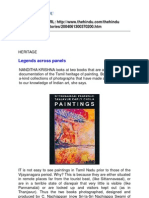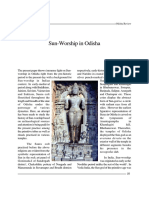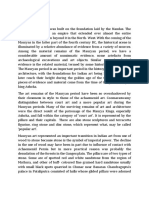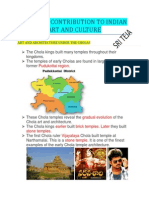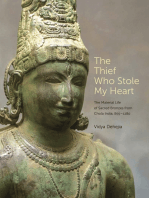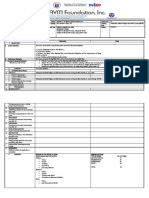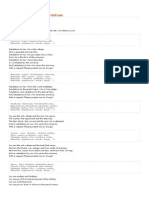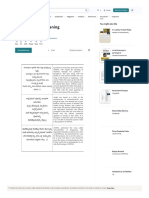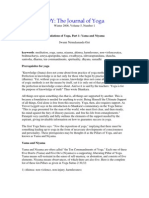0 ratings0% found this document useful (0 votes)
10 viewsChola Art
Chola Art
Uploaded by
Avantika YadavCopyright:
© All Rights Reserved
Available Formats
Download as DOCX, PDF, TXT or read online from Scribd
Chola Art
Chola Art
Uploaded by
Avantika Yadav0 ratings0% found this document useful (0 votes)
10 views2 pagesCopyright
© © All Rights Reserved
Available Formats
DOCX, PDF, TXT or read online from Scribd
Share this document
Did you find this document useful?
Is this content inappropriate?
Copyright:
© All Rights Reserved
Available Formats
Download as DOCX, PDF, TXT or read online from Scribd
Download as docx, pdf, or txt
0 ratings0% found this document useful (0 votes)
10 views2 pagesChola Art
Chola Art
Uploaded by
Avantika YadavCopyright:
© All Rights Reserved
Available Formats
Download as DOCX, PDF, TXT or read online from Scribd
Download as docx, pdf, or txt
You are on page 1of 2
CHOLA ART
1. The temple dance of Bharatnatyam developed during the chola reign .
Females who were the consorts of god (devadasis), they performed this
dance form .
2. Ancient Hindu metal images barely have any inscriptions , they are
studied vis a vis stone inscription . Old Nataraja figures are found in
Kailash Nath swami temple and so on . Acc to Srinivasan , the bronze
Nataraja also emerged during this period however as Sharada Srinivasa
analysis of archaeometry iconography and literary evidences shows that
the bronze representation of Shivas Anand tandav first appeared in
pallava period between the 7th and mid 9 centuries . He analysis 130
images of pallava and chola period and she claims that the 2 Nataraja
bronze – one found and kunniyur in the tanjavur district , another is in
the British museum .
3. These have traditionally been described as chola bronzes , in all
likelihood they were made in the pallava period .
4. Chola period is known for the finesse of its metal images . Tanjavur was
the epicenter for such images . The difference between metal images of
the north and south is that – the north Indian ones were hollow while
the south Indian ones were solid though both were made through the
wax method . Another difference is that the north Indian ones are made
from 8 metals (ashthadhatu) and the ones from south are made with 5
metals (panchdhatu ).
5. Copper , gold , silver , tin and lead were the 5 metals used in the south
India . Iron , mercury and Zinc were perhaps not used in the south
nevertheless , these were a part of the ashthadhatu .
6. More and more of gold and copper were used in the south due to their
extreme familiarity with these metals .
7. These style of metal images were very similar to their stone
counterparts . They were clothed and decorated . Some southern images
were carried in procession while other were used for temple rituals .
8. Nataraja was a perpetually emerging murti in the chola period .
9. Some metal buddhist images are also found , Krishna images are also
found .
10.Nat mandir , Natana sabha there were 2 types of shiva images depicting
Ananda tandav and Rudra tandav .
11.The lower hand gajahastha which is pointed towards the lifted foot this
is symbolic of the refuge of the world under is feet . The right hand is the
position of releasing the Abhay pose . Shiva is dancing on a dwarf called
muyalaka , this is symbolic of over coming the evil of the world . The left
leg is thrusted out .
12.The image is symbolic of him being the creator and the destroyer . The
rudra tandav shows fire and the damroo which are symbolic of these .
13.Acc to Srinivasan the chola image of the metallic gods are coming so late
due to the poor tinsel weight of stone in comparison to metal . The
carvers face a difficulty in carving the left leg in tone of shiva .
14.The dreadlocks of lord shiva are in the air and they touch the rim of the
circle .
15.In south india dance of shiva found its way in the poetry like
manikkavachakar by nayanmar .He says the dancer should be praised for
his skills . Cholas patronised Shaivism so a great rise in Shaivism can be
noted . A great rise in the worship of shiva’s family like skanda/murgan ,
ganesha and Parvati is also seen .
16.Shiva was mostly worshipped in the Ananda Tandav form , not the Rudra
one cause that depicts the dance of sole destruction .
You might also like
- Bhagavad Gita in Daily LifeDocument6 pagesBhagavad Gita in Daily LifeJagadish Prasad100% (1)
- How To Use The Sri Yantra Properly - Electromagnetic Meditation Print-OutDocument1 pageHow To Use The Sri Yantra Properly - Electromagnetic Meditation Print-OutOriginal DeYon95% (21)
- South-Indian Images of Gods and Goddesses PDFDocument316 pagesSouth-Indian Images of Gods and Goddesses PDFspandaa100% (1)
- Taming of The Demons - Violence and Liberation in Tibetan Buddhism, The - Jacob P. DaltonDocument1,458 pagesTaming of The Demons - Violence and Liberation in Tibetan Buddhism, The - Jacob P. DaltonMarco Passavanti91% (11)
- UPSC Civil Services Examination: UPSC Notes (GS-I) Topic: Indian Bronze Sculptures (Art and Culture Notes For UPSC)Document3 pagesUPSC Civil Services Examination: UPSC Notes (GS-I) Topic: Indian Bronze Sculptures (Art and Culture Notes For UPSC)SreeNo ratings yet
- Indian Bronze Sculptures UpscDocument4 pagesIndian Bronze Sculptures Upscகாட்டு வாசிNo ratings yet
- Indian Bronze SculpturesDocument6 pagesIndian Bronze SculpturesVishnu GirishNo ratings yet
- Chola Bronzes - AnswerDocument5 pagesChola Bronzes - AnswerSehar Sabharwal 200893No ratings yet
- 18 Indian Bronze Sculpture (Indian Culture Series - NCERT) PDFDocument4 pages18 Indian Bronze Sculpture (Indian Culture Series - NCERT) PDFsarawalem1No ratings yet
- Music and Dance Traditions in Kerala Temple Iconography.1. DR Suvarna Nalapat TrustDocument61 pagesMusic and Dance Traditions in Kerala Temple Iconography.1. DR Suvarna Nalapat TrustDr Suvarna Nalapat100% (1)
- A Short Survey of Dances of IndiaDocument11 pagesA Short Survey of Dances of IndiaVidit DixitNo ratings yet
- Taittiriya Aryanaka, Kena, Mundaka Upanishads, Sankhayana Grihasutras Mention Durga in Her Various Forms The SoumayaDocument45 pagesTaittiriya Aryanaka, Kena, Mundaka Upanishads, Sankhayana Grihasutras Mention Durga in Her Various Forms The SoumayaMonidipa DeyNo ratings yet
- Chapter 7 PDFDocument6 pagesChapter 7 PDFAbhishek VyasNo ratings yet
- Grade 11 - Chapter 9 - Indian Bronze SculptureDocument12 pagesGrade 11 - Chapter 9 - Indian Bronze Sculpturemonicabcreative2No ratings yet
- Chapter 7Document10 pagesChapter 7kj197622No ratings yet
- Indian Art (R)Document13 pagesIndian Art (R)Sambit MishraNo ratings yet
- Great Living Chola in Conversation With DR Nagaswamy EditedDocument12 pagesGreat Living Chola in Conversation With DR Nagaswamy EditedSiva SubramaniNo ratings yet
- Introduction To Indian Art - Class 11-9Document15 pagesIntroduction To Indian Art - Class 11-9jacksparrow68977No ratings yet
- Emergence of Saivism in Andhra Dr. D. Kiran Kranth ChoudaryDocument18 pagesEmergence of Saivism in Andhra Dr. D. Kiran Kranth Choudarykkkotha2366No ratings yet
- Shiva-The Cosmic DancerDocument20 pagesShiva-The Cosmic DancerGrapes als PriyaNo ratings yet
- Prabhavali Fragment PDFDocument6 pagesPrabhavali Fragment PDFdevjain.progamer.365No ratings yet
- Jainism in Odisha Chapter 5Document30 pagesJainism in Odisha Chapter 5Bikash DandasenaNo ratings yet
- Indian Traditional Musical InstrumentsDocument3 pagesIndian Traditional Musical InstrumentsPiriya94No ratings yet
- 07 Chapter 2Document23 pages07 Chapter 2HaridasNo ratings yet
- Indian DancesDocument7 pagesIndian DancesitsankurzNo ratings yet
- 5 6185824582184730858Document9 pages5 6185824582184730858Rama BaiNo ratings yet
- Dance and Musics of IndiaDocument31 pagesDance and Musics of IndiavikasutsavNo ratings yet
- NIOS Painting Chapter 2Document10 pagesNIOS Painting Chapter 2Samuel ThomasNo ratings yet
- 12 Chapter5 PDFDocument22 pages12 Chapter5 PDFshilpaNo ratings yet
- Sun Images StudiesDocument75 pagesSun Images Studiesshilpa swamyNo ratings yet
- Art of Mauurya Period: Pillars, Sculptures and Rock-Cut ArchitectureDocument3 pagesArt of Mauurya Period: Pillars, Sculptures and Rock-Cut ArchitecturemirzaNo ratings yet
- Jaina Sculpture in Orissa State MuseumDocument4 pagesJaina Sculpture in Orissa State MuseumHemant JainNo ratings yet
- Buddhist Bronzes From The Sandor P Fuss Collection PDFDocument52 pagesBuddhist Bronzes From The Sandor P Fuss Collection PDFDhamma_Storehouse100% (1)
- Indian Classical DancesDocument4 pagesIndian Classical DancesAkshayJhaNo ratings yet
- Dance in IndiaDocument15 pagesDance in Indiakremlin23455No ratings yet
- SculptureDocument11 pagesSculpturetishabhatt55No ratings yet
- WeB India 123Document3 pagesWeB India 123praveensunny20No ratings yet
- Painting BookDocument6 pagesPainting BooksvprskNo ratings yet
- Coinage in IndiaDocument14 pagesCoinage in Indiavinayak.jhaNo ratings yet
- History CADocument73 pagesHistory CAdenleyNo ratings yet
- Sun Worship in Odisha PDFDocument8 pagesSun Worship in Odisha PDFNiraj Kumar100% (2)
- Shiva and Parvati EssayDocument4 pagesShiva and Parvati EssayAditya KarandikarNo ratings yet
- Ancient Coins of OrissaDocument6 pagesAncient Coins of OrissaResackNo ratings yet
- SculpturesDocument4 pagesSculptureskanak karihalooNo ratings yet
- DANCEDocument4 pagesDANCEhimanshiNo ratings yet
- Contribution of CoinsDocument13 pagesContribution of CoinsRobertBr2No ratings yet
- 08 - Chapter 2 - 2Document39 pages08 - Chapter 2 - 2Ari MVPDLNo ratings yet
- DR Sushma Ahuja Jhalarapatan Sun TempleDocument52 pagesDR Sushma Ahuja Jhalarapatan Sun Templeapi-268482678No ratings yet
- An Extant Sculpture of Bhairava'Document3 pagesAn Extant Sculpture of Bhairava'singingdrumNo ratings yet
- Mauryan ArtDocument6 pagesMauryan ArtsmrithiNo ratings yet
- Cholas - Contribution To Indian Art and Culture: Pudukottai RegionDocument12 pagesCholas - Contribution To Indian Art and Culture: Pudukottai RegionM Teja100% (1)
- NatarajaDocument2 pagesNatarajaAspirant AspirantNo ratings yet
- NotesDocument25 pagesNotesira.cyber03No ratings yet
- Crafts & Technology, Science & Mathematics, Medicine & GeographyDocument10 pagesCrafts & Technology, Science & Mathematics, Medicine & GeographySwadhin NandaNo ratings yet
- INDIAN CULTURE - Final PDFDocument204 pagesINDIAN CULTURE - Final PDFhelloitskalaiNo ratings yet
- A Comprehensive Approach For UPSC Pre & Mains: UPSC Civil Services ExamDocument204 pagesA Comprehensive Approach For UPSC Pre & Mains: UPSC Civil Services ExamPrasant SahayNo ratings yet
- Anishka Saxena Ix - C English HHWDocument16 pagesAnishka Saxena Ix - C English HHWAnishka SaxenaNo ratings yet
- INDIAN TEMPLE SCULPTURE RevisedDocument8 pagesINDIAN TEMPLE SCULPTURE Revisedlicab58347No ratings yet
- Musical InstrumentsDocument12 pagesMusical InstrumentsChan ChanNo ratings yet
- Making a Canon: Ananda K. Coomaraswamy, Sri Lanka, and the Place of Buddhist ArtFrom EverandMaking a Canon: Ananda K. Coomaraswamy, Sri Lanka, and the Place of Buddhist ArtNo ratings yet
- Arts of India: From Prehistoric to Modern TimesFrom EverandArts of India: From Prehistoric to Modern TimesRating: 5 out of 5 stars5/5 (6)
- The Thief Who Stole My Heart: The Material Life of Sacred Bronzes from Chola India, 855–1280From EverandThe Thief Who Stole My Heart: The Material Life of Sacred Bronzes from Chola India, 855–1280No ratings yet
- Paper Yogatattvopanishad The SCHOOL of The WISDOM 2012-2013-Rev1Document12 pagesPaper Yogatattvopanishad The SCHOOL of The WISDOM 2012-2013-Rev12010SUNDAY100% (1)
- Sampa LhundrupDocument3 pagesSampa LhundrupTashi DubjurNo ratings yet
- Buddhism and VegetarianismDocument9 pagesBuddhism and VegetarianismNeven IlakNo ratings yet
- Hindi Songs 68, 69 SAHAJ YOGINIDocument2 pagesHindi Songs 68, 69 SAHAJ YOGINItanaha100% (1)
- Colleges in Delhi University 2024 PDF by NirajDocument5 pagesColleges in Delhi University 2024 PDF by NirajnationalnetworkdelhiNo ratings yet
- DLL Iwrs Week16 DaaDocument3 pagesDLL Iwrs Week16 Daadonna abreraNo ratings yet
- HolidaysDocument2 pagesHolidaysDr.L.V.PRASAD MeesaragandaNo ratings yet
- Thanksgiving and The Meaning of Yajnas in The Bhagavad GitaDocument7 pagesThanksgiving and The Meaning of Yajnas in The Bhagavad Gitavlaxmanan100% (1)
- Sri Durga Apad Udharaka Stotram - Hindupedia The Hindu EncyclopediaDocument3 pagesSri Durga Apad Udharaka Stotram - Hindupedia The Hindu EncyclopediaKavitha BusireddyNo ratings yet
- WWW Scribd Com Document 252015219 Tiruppavai With MeaningDocument10 pagesWWW Scribd Com Document 252015219 Tiruppavai With MeaningJayanthNo ratings yet
- Pointers On The PathDocument3 pagesPointers On The PathSatinder DhimanNo ratings yet
- Pandavleni CavesDocument3 pagesPandavleni CavesJerry PerezNo ratings yet
- WWW Hinduism Co Za Motherho HTMDocument23 pagesWWW Hinduism Co Za Motherho HTMlarevo0% (1)
- Mind of Nama PrabhuDocument7 pagesMind of Nama PrabhuSantoshNo ratings yet
- Ekatmata StotraDocument12 pagesEkatmata StotraKhirodModiNo ratings yet
- RG (2015 16)Document18 pagesRG (2015 16)tejasNo ratings yet
- 8 BeatitudesDocument6 pages8 Beatitudesbrando laciaNo ratings yet
- Ancient Indian Political Thought: Unit IDocument18 pagesAncient Indian Political Thought: Unit IFarah Shaheryar100% (1)
- Nakshatrams and Vedic Astrology Deities and DescriptionsDocument3 pagesNakshatrams and Vedic Astrology Deities and DescriptionsSonofspider Lanmines50% (2)
- Ya Ma FoundDocument3 pagesYa Ma FoundCaroline HopperNo ratings yet
- Daniella - Ericson Earl Nanditha RC Dtaylor Diane Ssusa. Com Vertisystem. ComDocument234 pagesDaniella - Ericson Earl Nanditha RC Dtaylor Diane Ssusa. Com Vertisystem. Comtej reddyNo ratings yet
- Bhakti Yoga at HomeDocument55 pagesBhakti Yoga at HomehemantkumaroneNo ratings yet
- Forgiveness PrayersDocument1 pageForgiveness PrayersReena DagahNo ratings yet
- The Practice of Yoga Part Two: Bhakti Yoga: by Reverend Jaganath CarreraDocument6 pagesThe Practice of Yoga Part Two: Bhakti Yoga: by Reverend Jaganath CarrerasrivatsaNo ratings yet
- Part-II: CHAPTER 2 Bhakti Sufi Traditions Class 12 Notes History Key Concepts in NutshellDocument12 pagesPart-II: CHAPTER 2 Bhakti Sufi Traditions Class 12 Notes History Key Concepts in NutshellGaurangi OberoiNo ratings yet
- Karma Indirectly Gives Impersonal Brahman. Sakäma-Karma GivesDocument22 pagesKarma Indirectly Gives Impersonal Brahman. Sakäma-Karma GivesDāmodar DasNo ratings yet
